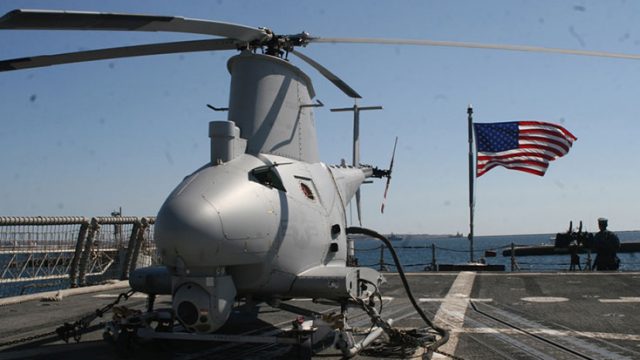Mississippi drone maker facing serious issues

WHIRLYBIRD: An MQ-8B Fire Scout unmanned aerial vehicle sits on the flight deck of the frigate U.S.S. Samuel B. Roberts
By Steve Wilson | Mississippi Watchdog
An unmanned aerial vehicle built in Moss Point might be on the chopping block after a recent Department of Defense report indicated the program is severely over budget.
The MQ-8 Fire Scout, a rotary wing UAV built by Northrop Grumman, is more than 70 percent over budget and in breach of the Nunn-McCurdy Amendment, which is designed to curtail cost growth in weapons procurement.
When a program is 15 percent over original per-unit cost estimates, it requires Congress to be notified. In the event a program — such as the Fire Scout — is 25 percent over budget or greater, it calls for the program’s termination unless the secretary of defense can certify:
- The program is vital to national security and no cheaper alternative is available
- New cost estimates are reasonable
- Management structure is adequate to manage and control unit costs
While the outlook is dire, Nunn-McCurdy isn’t an automatic death sentence. Only two programs — the U.S. Army’s Future Combat System armored vehicle and the U.S. Marine Corps Expeditionary Fighting Vehicle — have been canceled under the terms of Nunn-McCurdy since its passage in 1982.
Total costs on the Fire Scout program have shot up from $2.79 billion to $3.47 billion. In the report, the Navy cited “an increased requirement for warfighter capabilities of the system and an overall reduction in the total air vehicle quantities” from 177 to 126 aircraft as reasons for the program’s rising costs.
Although official per-unit costs weren’t released, they can be extrapolated from the program numbers. Unit costs have increased from $15.7 million to $27.5 million, an increase of more than 75 percent.
The Navy deleted 17 Fire Scouts from its 2015 budget, which begins Oct. 1, to be purchased over the next five years.
Calls and e-mails to the Navy project office were not returned.
While most UAVs take off and land like a manned airplane, the Fire Scout is based on the airframe of a helicopter, the Schweizer 333 (B-model) and the Bell 407 Jet Ranger (C-model). The UAV is designed to provide real-time surveillance imagery to its mothership (either an Oliver Hazard Perry class frigate or the Littoral Combat Ship) and has a precision-attack capability, certified in testing last year with the Advanced Precision Kill Weapon System, a laser-guided rocket. That capability, according to the same report, still requires more testing.
“The Fire Scout program has proven to be highly successful,” Northrop Grumman spokesman Warren Comer said in a statement. “Northrop Grumman is working closely with the U.S. Navy to meet the urgent needs of Naval and Special Operations Forces commanders while incorporating improved capabilities into the Fire Scout system.”
The program has endured some hiccups along the way. In 2010, one of the Fire Scouts was destroyed after it became unresponsive to commands during testing at Naval Air Station Patuxent River in Maryland and wandered into restricted airspace around Washington, D.C. Another was shot down in 2011 by pro-Gaddafi rebels in Libya and two more were lost in 2012, one off the coast of Africa and another in Afghanistan.
Northrop Grumman’s UAV manufacturing facility in Moss Point also produces part of the RQ-4 Global Hawk UAV.
Contact Steve Wilson at swilson@watchdog.org
Get regular updates on Mississippi through our Facebook or Twitter accounts







